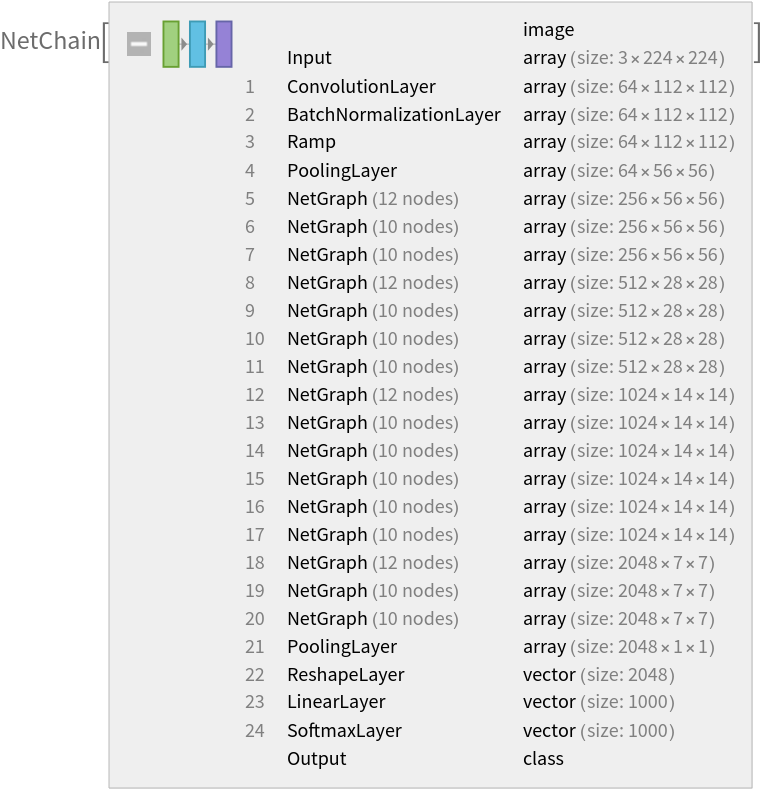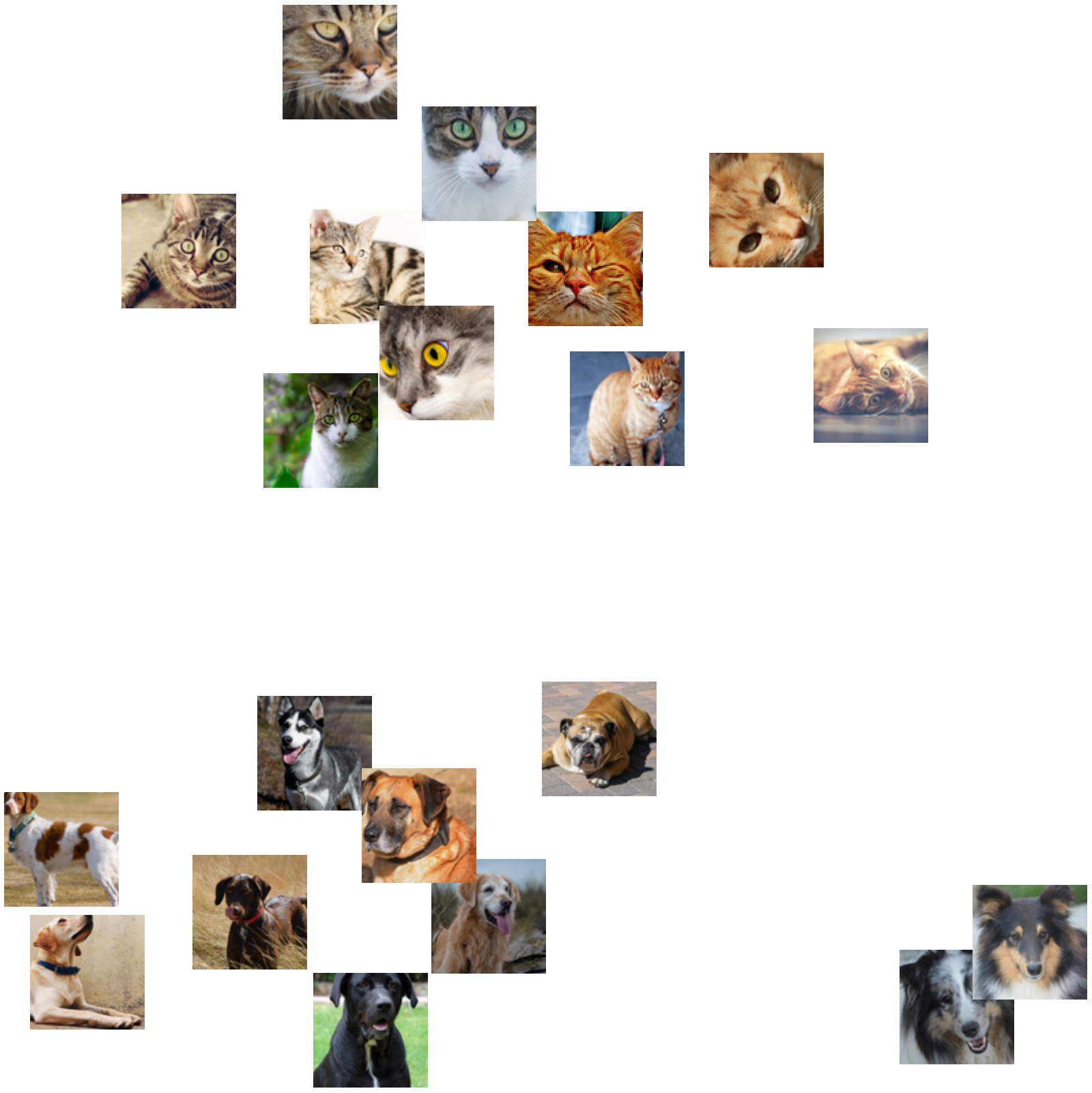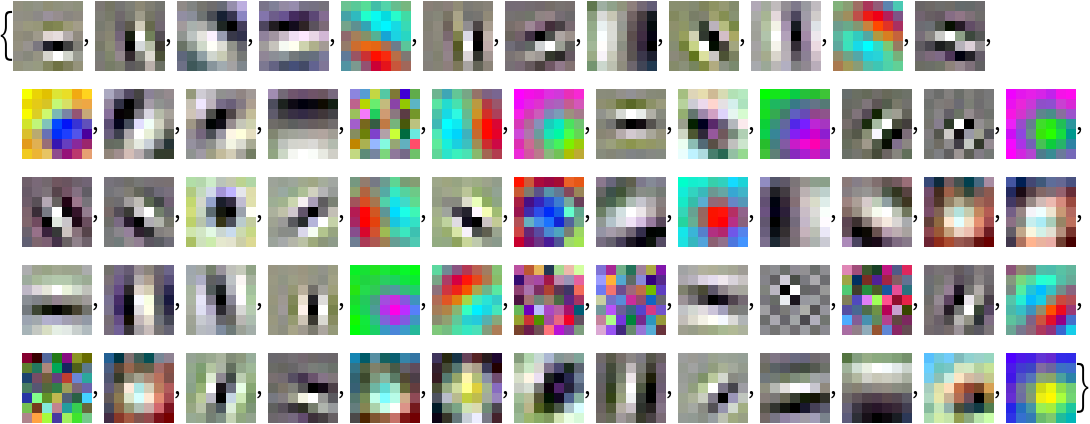Resource retrieval
Get the pre-trained net:
Basic usage
Classify an image:
The prediction is an Entity object, which can be queried:
Get a list of available properties of the predicted Entity:
Obtain the probabilities of the ten most likely entities predicted by the net:
An object outside the list of the ImageNet classes will be misidentified:
Obtain the list of names of all available classes:
Feature extraction
Remove the last three layers of the trained net so that the net produces a vector representation of an image:
Get a set of images:
Visualize the features of a set of images:
Visualize convolutional weights
Extract the weights of the first convolutional layer in the trained net:
Show the dimensions of the weights:
Visualize the weights as a list of 64 images of size 7x7:
Transfer learning
Use the pre-trained model to build a classifier for telling apart images of dogs and cats. Create a test set and a training set:
Remove the linear layer from the pre-trained net:
Create a new net composed of the pre-trained net followed by a linear layer and a softmax layer:
Train on the dataset, freezing all the weights except for those in the "linearNew" layer (use TargetDevice -> "GPU" for training on a GPU):
Perfect accuracy is obtained on the test set:
Net information
Inspect the sizes of all arrays in the net:
Obtain the total number of parameters:
Obtain the layer type counts:
Display the summary graphic:
Export to MXNet
Export the net into a format that can be opened in MXNet:
Export also creates a net.params file containing parameters:
Get the size of the parameter file:
The size is similar to the byte count of the resource object:

![(* Evaluate this cell to get the example input *) CloudGet["https://www.wolframcloud.com/obj/5e9b34fa-ac6d-4660-8c65-5b420be1f03a"]](https://www.wolframcloud.com/obj/resourcesystem/images/58a/58aed759-7ada-46c8-9bce-dc7938690a0e/4d9883c8694184f4.png)

![(* Evaluate this cell to get the example input *) CloudGet["https://www.wolframcloud.com/obj/330fcc3f-7b49-472a-81b3-963a25de3ac0"]](https://www.wolframcloud.com/obj/resourcesystem/images/58a/58aed759-7ada-46c8-9bce-dc7938690a0e/419bc6cb9d8b48de.png)

![(* Evaluate this cell to get the example input *) CloudGet["https://www.wolframcloud.com/obj/466f967f-6f6f-44ea-927a-3ca9ebd65002"]](https://www.wolframcloud.com/obj/resourcesystem/images/58a/58aed759-7ada-46c8-9bce-dc7938690a0e/311abe181e38cb57.png)
![EntityValue[
NetExtract[
NetModel["Wide ResNet-50-2 Trained on ImageNet Competition Data"], "Output"][["Labels"]], "Name"]](https://www.wolframcloud.com/obj/resourcesystem/images/58a/58aed759-7ada-46c8-9bce-dc7938690a0e/3ec257a60a0c1e16.png)


![(* Evaluate this cell to get the example input *) CloudGet["https://www.wolframcloud.com/obj/dae097ce-a2a1-4910-b7e2-a552897a0378"]](https://www.wolframcloud.com/obj/resourcesystem/images/58a/58aed759-7ada-46c8-9bce-dc7938690a0e/760008d811e732a7.png)


![(* Evaluate this cell to get the example input *) CloudGet["https://www.wolframcloud.com/obj/3d67e1d3-ccab-4dac-97ab-41ea40d9fef0"]](https://www.wolframcloud.com/obj/resourcesystem/images/58a/58aed759-7ada-46c8-9bce-dc7938690a0e/2ec63268392d6ebc.png)
![(* Evaluate this cell to get the example input *) CloudGet["https://www.wolframcloud.com/obj/5aa44ec3-cb88-43a8-b5a3-b8a002b61486"]](https://www.wolframcloud.com/obj/resourcesystem/images/58a/58aed759-7ada-46c8-9bce-dc7938690a0e/4894433c6e78e161.png)

![newNet = NetChain[<|"pretrainedNet" -> tempNet, "linearNew" -> LinearLayer[], "softmax" -> SoftmaxLayer[]|>, "Output" -> NetDecoder[{"Class", {"cat", "dog"}}]]](https://www.wolframcloud.com/obj/resourcesystem/images/58a/58aed759-7ada-46c8-9bce-dc7938690a0e/60c6f26441754dee.png)



